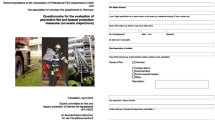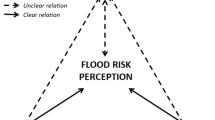Abstract
Urban floods are sudden phenomena normally characterized by short flooding durations and devastating effects due to the high concentrations of persons, goods, and properties located in urban areas. In these cases, uncontrolled runoff can flow on urban streets, creating a significant hazard for pedestrians and vehicles. The safety of people can be compromised when they are exposed to flows that exceed their ability to remain standing or to traverse flow paths. With the aim of studying the stability of pedestrians in flooded street during storm events, a model representing an urban street in real scale was designed and built. Following a specific protocol that considering several flow rates (up to 500 l/s) and different longitudinal slopes (up to 10 %), 834 tests, using 23 human subjects, were carried out in good and poor light conditions. Hazard conditions were classified into three groups (low, medium, and high), and the parameters for which these conditions occurred were recorded. Results showed that for subjects weighing 50–60 daN (50–60 kg mass) and flow depths between 9 and 16 cm, velocities of 1.5–2 m/s can generate loss of stability due to phenomena of dragging or overturning. Empirical expressions were proposed to relate human subject characteristics (weight and height) and limiting flow conditions at which loss of stability occurs.










Similar content being viewed by others
References
Abt SR, Wittler RJ, Taylor A, Love DJ (1989) Human stability in a high flood hazard zone. AWRA Water Resour Bull 25(4):881–890
Agricultural and Resource Management Council of Australia and New Zealand (ARMC) (2000) Floodplain management in Australia: best practice principles and guidelines. CSIRO Publishing, Collingwood
Belleudy P (2004) Risques Hydro-météorologiques, crues et inondations/risque, aléa et vulnérabilité/DDS-TUE364/9
Clark County Regional Flood Control District (CCRFCD) (1999) Hydrological criteria and drainage design manual. Clark County, USA
Clavegueram de Barcelona SA (CLABSA) (2006) Plan Integral de Clavegueram de Barcelona 2006 (PICBA06). Master Drainage Plan of Barcelona, Planning and project department
Cox RJ, Shand TD, Blacka MJ (2010) Australian rainfall and runoff. Revision project 10: appropriate safety criteria for people. Stage I report. Engineers Australia, Water Engineering
Department of Infrastructure, Planning and Natural Resources (DIPNR) (2005) NSW Floodplain Development Manual. New South Wales Government, Sydney
Federal Emergency Management Agency (FEMA) (1979). The floodway: a guide for community permit officials. HUD-529-FIA
Foster DN, Cox RJ (1973) Stability of children on roads used as floodways. Technical Report No. 73/13, Water Research Laboratory, The University of New South Wales, Manly Vale, NSW, Australia
Gómez M, Macchione F, Russo B (2009) Comportamiento hidráulico de las calles durante lluvias extremas en zonas urbanas (Hydraulic behaviour of urban flooded streets during heavy storm events). Ingeniería hidráulica en México 24(3):51–62
Gómez M, Macchione F, Russo B (2010) Hazard criteria related to urban flooding produced by heavy storm events. Proceedings of 1st European Congress of the IAHR, Edinburgh, 4–6 May 2010
Gómez M, Macchione F, Russo B (2011) Methodologies to study the surface hydraulic behaviour of urban catchments during storm events. Water Sci Technol 63(11):2666–2673
Greco V (2011) Studio dei profili di velocità di una corrente durante allagamenti urbani e analisi della pericolosità in un tratto di strada. Graduation Thesis, University of Calabria, Italy
Institution of Engineers (1987) Australia Rainfall and Runoff. In: Pilgrim DH (ed), Vol 1&2. Australia
Jonkman SN, Penning-Rowsell E (2008) Human instability in flood flows. J Am Water Resour As 44(4):1–11
Karvonen RA, Hepojoki HK, Huhta HK, Louhio A (2000) The Use Of Physical Models In Dam-Break Flood Analysis, Development of Rescue Actions Based on Dam-Break Flood Analysis (RESCDAM). Final report of Helsinki University of Technology, Finnish Environment Institute
Kelman I (2002) Physical flood vulnerability of residential properties in coastal eastern England. PhD. Dissertation, University of Cambridge, England
Nanía L (1999) Metodología numérico experimental para el análisis del riesgo asociado a la escorrentía pluvial en una red de calles. PhD. Dissertation, Technical University of Catalonia, Spain
Ramsbottom D, Floyd P, Penning-Rowselll E (2006) Flood risks to people; phase 2: project record. FD 2321/PR. Department for Environment Food and Rural Affairs, UK, p 166
Regione Liguria (1993) Piano di bacino stralcio per la difesa idraulica e idrogeologica. Autoritá di Bacino Regionale. Ambito di Bacino No. 7, Dianese, Italia
Reiter P (2000) International methods of Risk Analysis, Damage evaluation and social impact studies concerning Dam-Break accidents. EU-Project RESCDAM. Helsinki PR Water Consulting
Rooseboom A, Basson MS, Loots CH, Wiggett JH, Bosman J (1986) Manual on road drainage. (2nd edn) National Transport Commission. Republic of South Africa
Russo B (2009) Design of surface drainage systems according to hazard criteria related to flooding of urban areas. PhD. Dissertation,Technical University of Catalonia, Spain
Shand D, Smith G, Blacka M (2010) Appropriate criteria for the safety and stability of people in stormwater design. Proceedings of National Conference of the Stormwater Industry Association, Sydney, Australia, 9–12 Nov 2010
Takahashi S, Endoh K, Muro ZI (1992) Experimental study on people’s safety against overtopping waves on breakwaters. Rep Port Harb Inst 34(849):4–31 (in Japanese)
Témez JR (1992) Control del desarrollo urbano en las zonas inundables. CICCP monographs, Madrid
Wright-Mc Laughlin Engineers (1969) Urban storm drainage criteria manual. Urban Drainage and Flood Control District, Denver
Yee M (2003) Human stability in floodways, Undergraduate Honours Thesis, School of Civil and Environmental Engineering, University of New South Wales, Sydney, Australia
Acknowledgments
The authors wish to thank the Spanish Ministry of Education and Science and the Agbar Foundation for their financial collaboration in several projects related to this work.
Author information
Authors and Affiliations
Corresponding author
Rights and permissions
About this article
Cite this article
Russo, B., Gómez, M. & Macchione, F. Pedestrian hazard criteria for flooded urban areas. Nat Hazards 69, 251–265 (2013). https://doi.org/10.1007/s11069-013-0702-2
Received:
Accepted:
Published:
Issue Date:
DOI: https://doi.org/10.1007/s11069-013-0702-2




